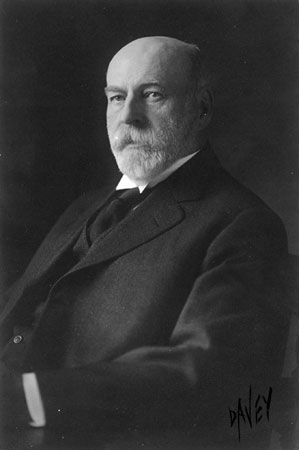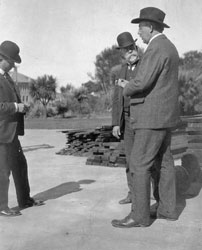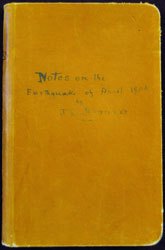Ele fez o primeiro boletim sísmico brasileiro
fonte:http://quake06.stanford.edu/centennial/gallery/people.html

John Casper Branner
Dr. Branner was born in New Market, Tennessee, in 1850, graduated from Cornell in 1882 and received his Ph. D. at the University of Indiana in 1885.
In 1891 Dr. Branner was selected by Stanford president David Starr Jordan as professor of geology, the first professor at Stanford. He was then connected with the University of Arkansas. He served as vice-president of Stanford from 1898 to 1913. He also served as Stanford's first librarian. When he arrived at Stanford, his book collection filled two box cars; the Register for 1891-2 stated, "students will have access to Professor Branner's private geological library, containing about 5,000 volumes."
Branner with President Jordan inspecting the university during reconstruction. Stanford Archives GP 2785. |
The 1906 earthquake caused great devastation, but it also presented an opportunity for scientific study. Now, Dr. Branner had a wealth of evidence about a major geological event available in his own backyard. Within days of the quake, Branner recruited students with photographic experience and equipment to document the section of the fault line located near campus. On May 1, 1906, the Daily Palo Alto Times published a short article by Branner, describing his initial observations of the Santa Cruz Fault Line.
Branner’s colleague, geologist Andrew C. Lawson at UC Berkeley, had meanwhile lost no time in establishing a commission of renowned scientists to study the massive rupture. The State Earthquake Investigation Commission included such luminaries as G.K. Gilbert (USGS), Harry Reid (Johns Hopkins), as well as Lawson and Branner. They attempted to map and record as much detail as possible along the San Andreas Fault rupture.
Dr. Branner's field notebook for 1906. Stanford Archives SC-34 Box 71. |
Although the university was officially closed until fall semester, field work in Stanford's Department of Geology and Mining continued over the summer. Under Professor Branner’s direction, students surveyed the San Andreas Fault along 198 miles. Findings were recorded in field notebooks and in photographs. Data collected on the Santa Cruz Quadrangle portion of the fault was included in The California Earthquake of April 18, 1906: Report of the State Earthquake Investigation Commission, published by the Carnegie Institution of Washington in 1908. Often called the Lawson report, after commission chair Andrew Lawson, the two volume report (with atlas) is considered an “invaluable compilation of post-1906 scientific investigations” by geologists today.
Little noticed at the time, some now say that most modern earthquake science owes its origins to what was published by that group of scientists in the Lawson report. Besides valuable observations, the report led to Reid’s formulation of “elastic rebound theory” (which describes how earthquakes release energy), Lawson’s recognition of the San Andreas Fault as a fault system stretching down to Mexico, and descriptions of how building design and local geology determine structural damage during an earthquake.
In 1913, the Stanford trustees honored Dr. Branner with the university's presidency when Dr. Jordan was promoted to the chancellorship. He retired as the university's second president in 1915 at age 65. He also resigned as head of the department of geology and mining, a post he occupied for 23 years. He was succeeded by Dr. Bailey Willis of the U.S.Geological Survey.
After retirement he was appointed by President Wilson in 1916 to investigate the cause of massive landslides affecting operations of the Panama Canal.
Dr. Branner was a recognized authority on the geology of South American republics, especially Brazil.
---
- Earthquakes in Brazil
- The Journal of Geology, Vol. 18, No. 4 (May - Jun., 1910), pp. 327-335
(article consists of 9 pages) - Published by: The University of Chicago Press
- Stable URL: http://www.jstor.org/stable/30079344

- J. C. BRANNER Earthquakes in Brazil
BULLETIN OF THE SEISMOLOGICAL SOCIETY OF AMERICA 1912 2: 105-117. - Livro disponível (http://www.archive.org/details/geologiaelementa00bran) na página está a primeiro boletim. (1915)



Nenhum comentário:
Postar um comentário